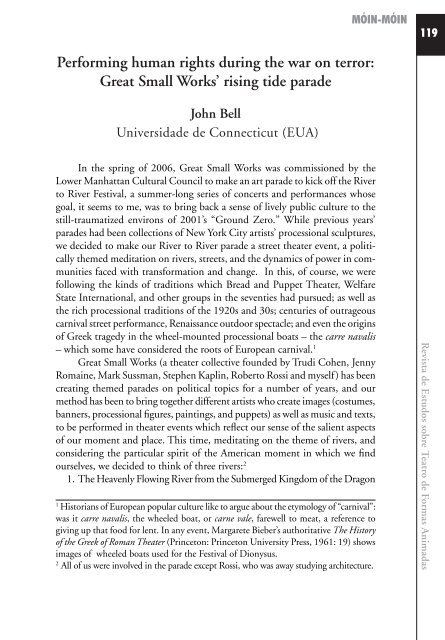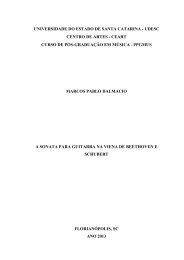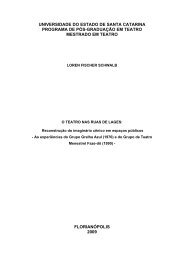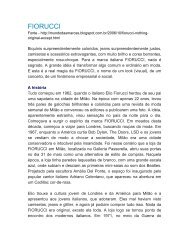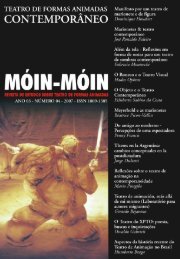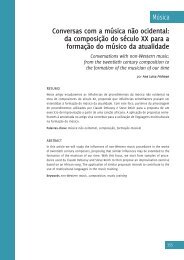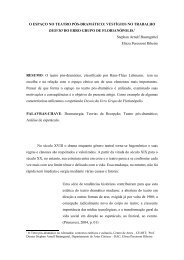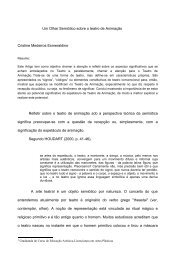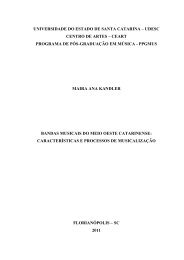Edição e distribuição www.designeditora.com.br Tipologia Adobe ...
Edição e distribuição www.designeditora.com.br Tipologia Adobe ...
Edição e distribuição www.designeditora.com.br Tipologia Adobe ...
Create successful ePaper yourself
Turn your PDF publications into a flip-book with our unique Google optimized e-Paper software.
Performing human rights during the war on terror:<<strong>br</strong> />
Great Small Works’ rising tide parade<<strong>br</strong> />
John Bell<<strong>br</strong> />
Universidade de Connecticut (EUA)<<strong>br</strong> />
In the spring of 2006, Great Small Works was <strong>com</strong>missioned by the<<strong>br</strong> />
Lower Manhattan Cultural Council to make an art parade to kick off the River<<strong>br</strong> />
to River Festival, a summer-long series of concerts and performances whose<<strong>br</strong> />
goal, it seems to me, was to <strong>br</strong>ing back a sense of lively public culture to the<<strong>br</strong> />
still-traumatized environs of 2001’s “Ground Zero.” While previous years’<<strong>br</strong> />
parades had been collections of New York City artists’ processional sculptures,<<strong>br</strong> />
we decided to make our River to River parade a street theater event, a politically<<strong>br</strong> />
themed meditation on rivers, streets, and the dynamics of power in <strong>com</strong>munities<<strong>br</strong> />
faced with transformation and change. In this, of course, we were<<strong>br</strong> />
following the kinds of traditions which Bread and Puppet Theater, Welfare<<strong>br</strong> />
State International, and other groups in the seventies had pursued; as well as<<strong>br</strong> />
the rich processional traditions of the 1920s and 30s; centuries of outrageous<<strong>br</strong> />
carnival street performance, Renaissance outdoor spectacle; and even the origins<<strong>br</strong> />
of Greek tragedy in the wheel-mounted processional boats – the carre navalis<<strong>br</strong> />
– which some have considered the roots of European carnival. 1<<strong>br</strong> />
Great Small Works (a theater collective founded by Trudi Cohen, Jenny<<strong>br</strong> />
Romaine, Mark Sussman, Stephen aplin, Roberto Rossi and myself) has been<<strong>br</strong> />
creating themed parades on political topics for a number of years, and our<<strong>br</strong> />
method has been to <strong>br</strong>ing together different artists who create images (costumes,<<strong>br</strong> />
banners, processional figures, paintings, and puppets) as well as music and texts,<<strong>br</strong> />
to be performed in theater events which reflect our sense of the salient aspects<<strong>br</strong> />
of our moment and place. This time, meditating on the theme of rivers, and<<strong>br</strong> />
considering the particular spirit of the American moment in which we find<<strong>br</strong> />
ourselves, we decided to think of three rivers: 2<<strong>br</strong> />
1. The Heavenly Flowing River from the Submerged ingdom of the Dragon<<strong>br</strong> />
1 Historians of European popular culture like to argue about the etymology of “carnival”:<<strong>br</strong> />
was it carre navalis, the wheeled boat, or carne vale, farewell to meat, a reference to<<strong>br</strong> />
giving up that food for lent. In any event, Margarete Bieber’s authoritative The History<<strong>br</strong> />
of the Greek of Roman Theater (Princeton: Princeton University Press, 1961: 19) shows<<strong>br</strong> />
images of wheeled boats used for the Festival of Dionysus.<<strong>br</strong> />
2 All of us were involved in the parade except Rossi, who was away studying architecture.<<strong>br</strong> />
MÓIN-MÓIN<<strong>br</strong> />
119<<strong>br</strong> />
Revista de Estudos so<strong>br</strong>e Teatro de Formas Animadas


